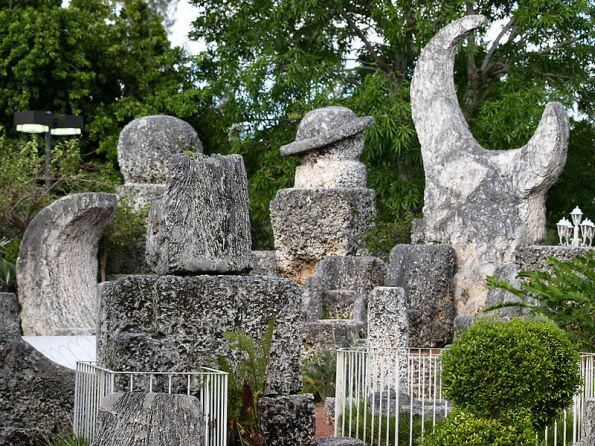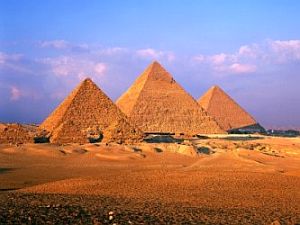Ancient Explorers – The Coral Castle of Homestead, Florida just may be the greatest one-man engineering feat of modern times. But while this odd, mostly open-air “castle” is contemporary, it shares something with one of the world’s greatest architectural mystery: Giza’s pyramids.
Why? Because just like those ancient edifices, the construction of Coral Castle is shrouded in mystery.
 Magnetism Meets Eccentric Immigrant
Magnetism Meets Eccentric Immigrant
Between the early 1920’s and 1950’s, a Latvian immigrant named Edward Leedskalnin built and then moved one of the greatest wonders of architecture in modern times: Coral Castle. Leedskalnin built the Castle with nothing more than an ancient understanding of magnetism.
How he built and then moved this monument from stone – single-handedly – defies our modern-day understanding of physics. What we do know is that he claimed to use magnetism and “the secrets of the pyramid builders”.
An 1,100-Ton Secret Taken to His Grave
Born on January 12, 1887, in Stāmeriena parish, Livonia, Leedskalnin was known for two things: Coral Castle and his fascination with Magnetism. In fact, as a student of magnetism, he applied his knowledge to understanding how ancient civilizations were able to build megalithic structures such as Stonehenge and of course, the pyramids of the Giza plateau.
Leedskalnin was diagnosed with terminaltuberculosis shortly after the turn of the 20th century, but spontaneously healed, stating that magnets had some effect on his disease. He then moved to Florida in 1919 where he began constructing the massive coral monument he called Rock Gate Park. Over the next 20 years, Leedskalnin moved some 1,100 tons (over 2 million pounds) of pure quarry rock to create his masterpiece.
Leedskalnin worked on Rock Gate Park until his death at the age of 64, taking the secret of its construction with him to the grave.
How Was it Really Built?
Whenever people asked Leedskalnin how he managed to man-handle the massive stones of Coral Castle, he refused to give a direct answer. Instead, he’d simply reply that he understood the laws of weights and physics. “I know the secrets of the people who built the pyramids” he’d say, without disclosing exactly what those secrets might be.
Mysterious “Beads of Light” and a “Perpetual Motion Holder”
 While his conversations were cryptic, Leedskalnin did give us an answer, albeit vaguely, through his published booklets on the theory of magnetism and the Castle. Today, most of these papers are long out of print, although excerpts are found throughout the web, and “Magnetic Current,” one of his booklets, can be found at Leedskalnin.com.
While his conversations were cryptic, Leedskalnin did give us an answer, albeit vaguely, through his published booklets on the theory of magnetism and the Castle. Today, most of these papers are long out of print, although excerpts are found throughout the web, and “Magnetic Current,” one of his booklets, can be found at Leedskalnin.com.
Working only at night and only when he was certain no one was watching, Leedskalnin managed to keep the secret of how he lifted massive blocks single-handedly. What he did say leaves us with more questions than answers.
He claimed, for example, that he could actually see “beads of light” on physical objects. These beads, according to Leedskalnin, were the physical manifestation of nature’s magnetic energy.
But Leedskalnin didn’t just claim to see magnetic energy. He also said that this was what he used, via some sort of mysterious “perpetual motion” holder, to lift any object, no matter how heavy. This device, whatever it may have been, would make the object behave as if it was in water, allowing him to move it without exerting any significant physical energy.
Graham Hancock, Pyramids and Heated Copper
Graham Hancock, one of today’s most outspoken and respected thought leaders in the field of ancient mysteries, provides us with some insight on exactly how Leedskalnin may have shaped the rocks to form Coral Castle, with his insights about Egypt’s pyramids.
Hancock speculated that Egypt’s pyramid builders may have used a form of heated copper to bend the shape of the massive stone blocks before placing them. Could this have been the same or similar method used by Leedskalnin? And instead of copper rods, might he have used – or “activated” – copper already contained within the rock, in the form of raw copper ore?
Wally Wallington
Fast forward to 2011 … Michigan resident Wally Wallington spent 40 years as a construction worker before moving, single-handedly, many of his own massive stones. Wallington claims to have “cracked the code” of this Leedskalnin’s mystery.
Wallington had been fascinated with how Stonehenge, the Pyramids of Egypt and Coral Castle had been built. After retiring, he dedicated most of his waking hours to unlocking the secret that allowed Leedskalnin to single-handedly build Coral Castle.
His goal: Replicate the process exactly in order to build a miniature Stonehenge in his garden.
Sticks, Stones and Levers
Starting out small, Wallington decided to move slabs of stock with his mechanism, then a barn, and kept going bigger and heavier until he went for a ton of pure cut rock. His efforts are paying off, and today he’s demonstrated this by lifting stones over a ton in weight.
Check out this video of Wally Wallington using these stunningly simple methods to move weighty blocks.
[youtube=https://youtu.be/vL8Ou82BEc0]
The FINAL SHOCKING CLUE That May Explain How A Sickly Man Used Ancient Wisdom To Build A Modern Wonder
While the mystery of how Ed Leedskalnin, a somewhat sickly and undernourished man, moved massive sized rocks from quarry to castle remains, there is one final clue that gives us insight into how he may have managed it ….
There are rumors surrounding Coral Castle, of Leedskilnan “singing” to the stones in the night, as he would secretly levitate them. Several children were also said to have seen him use “ice cream cones” to make the rocks “float” into place.
While the notion of “ice cream cones” may seem ridiculous, Michael Tellinger, an expert on South Africa’s mysterious Adam’s Calendar, has put together a hypothesis that may support these rumors.
Sound Technology of the Ancients?
Tellinger argues convincingly for the use of sound technology among ancient people as a means of levitating megalithic rocks into place. In his presentations, he shares video demonstrating the use of sound to move small objects. Tellinger also demonstrates the many cone-shaped stones found at certain sites … stones that literally ring when struck together!
Could something so simple as cone-shaped stones have been used to build the likes of sites like the Pyramids, Gobekli Tepe, Stonehenge, Adam’s Calendar … or even the Coral Castle?
What do YOU think about Edward Leedskalnin’s Coral Castle, and how it was built? Share your thoughts below.
SF Source Ancient Explorers Sep 2015
[widget id=”text-44″]

ANCIENT TECHNOLOGY OF SOUND AND STONES
An article on my website on this fascinating subject:
http://www.constancedemby.com/healing.html
Beyond Egypt, in ancient Israel, the Old Testament book of First Kings 6:7, records that in the building of Solomon’s Temple, “Only blocks of undressed stone from the quarry were used; no hammer or ax or any iron tool whatsoever was heard in the house while it was being built.” This feat was accomplished, the Talmudic traditions recount, with the use of a stone called the Shamir, which caused stone to be separated and shaped by vibration, and levitated into place with sound.
The Mahatma Dhut Kuhl, in his “A Treatise on Cosmic Fire,” stated: “The laws governing the erection of large buildings and the handling of great weights will someday be understood in terms of sound…. They were raised through the ability of the early builders to create a vacuum through sound.”
In nearby Chaldea, the ancient Magi were said to generate a similar force called, in the Aramaic, “rukha shakintu,” by using rods of gold with special energising powers. Of interest in this respect is the Chaldean work, the “Sifr’ala,” which dates back more than 5000 years and, though fragmentary, is a lengthy work filling almost 100 pages of English translation.
Farther to the east, in India, researcher Andrew Thomas reported that levitation is still performed to this day using chanting. In the village of Shivapur, near Poona, is a little mosque dedicated to the Sufi holy man Qamar Ali Dervish. Outside, in the courtyard of the mosque, is a stone weighing 138 pounds and during daily prayer, 11 devotees surround the stone, repeating the holy man’s name. When they read a certain pitch, the 11 men are able to lift the stone by using one finger each. As soon as the chanting stops, the devotees jump back, for the stone resumes its weight and falls to the ground with a heavy thud.
As Thomas noted: “The key seems to be in the chanting, and the 11 voices must be the required formula to achieve the correct pitch that makes the boulder’s vibrations change and renders it seemingly weightless or at least lighter. The name of the saint is probably unimportant; the frequency is the key factor. It is a similar principle to the one whereby a trained singer can strike and hold a note that matches a wine glass and shatters it.”
A second fascinating eyewitness account of modern levitation, this one from Tibet, was reported by Swedish aircraft industrialist Henry Kjellson, who travelled through the Himalayas in the post-war era. Kjellson described how Tibetan monks hauled stones measuring one-and-one-half metres square by yak up to a plateau, and placed them in a specifically designed hole, bowl-shaped at one metre in diameter and 15 centimetres deep in the centre. The hole was situated 100 metres from a cliff wall, 400 metres high, on top of which was a building to be constructed.
Behind the hole, by 63 metres, stood 19 musicians, and behind each of them 20 priests radiating out in lines, separated from one another in groups at five degree intervals, forming a quarter circle with the hole as its focal centre. These distances appear to have been of utmost importance, for all were carefully measured by the monks using lengths of knotted leather. The musicians possessed a total of 13 drums of three different sizes, and alternating between them were six large trumpets.
On command, the drums and trumpets were sounded, and the priests chanted in unison, together forming sharp blasts of sound at a beat of two-per-minute. After four minutes, Kjellson observed that the stones placed in the target hole began to wobble, move side to side, and then as the beats of sound increased, they suddenly soared the 400 metres in a parabolic arc to the top of the cliff. In this manner, Kjellson recorded that the monks were able to move five or six blocks an hour.
Significantly, the ancient Chinese medicine men also used the element jade as a healing tool, and possessed singing stones made of flat pieces of jade, which vibrated pleasant and soothing notes when struck, calming and aiding in the recuperation of their patients. The great tone of nature the Chinese called the Kung, corresponding in our music scale to F. To the neighboring Tibetans, the notes of A, F, and G were sounds of power.
In ancient times, the Emporer would keep the peace by a very simple means. Each year he would travel with his entourage to the various provinces.
He would listen, and then carefully tune the notes of the scale.
And in that way, peace reigned for thousands of years.
– Geoffrey Keyte